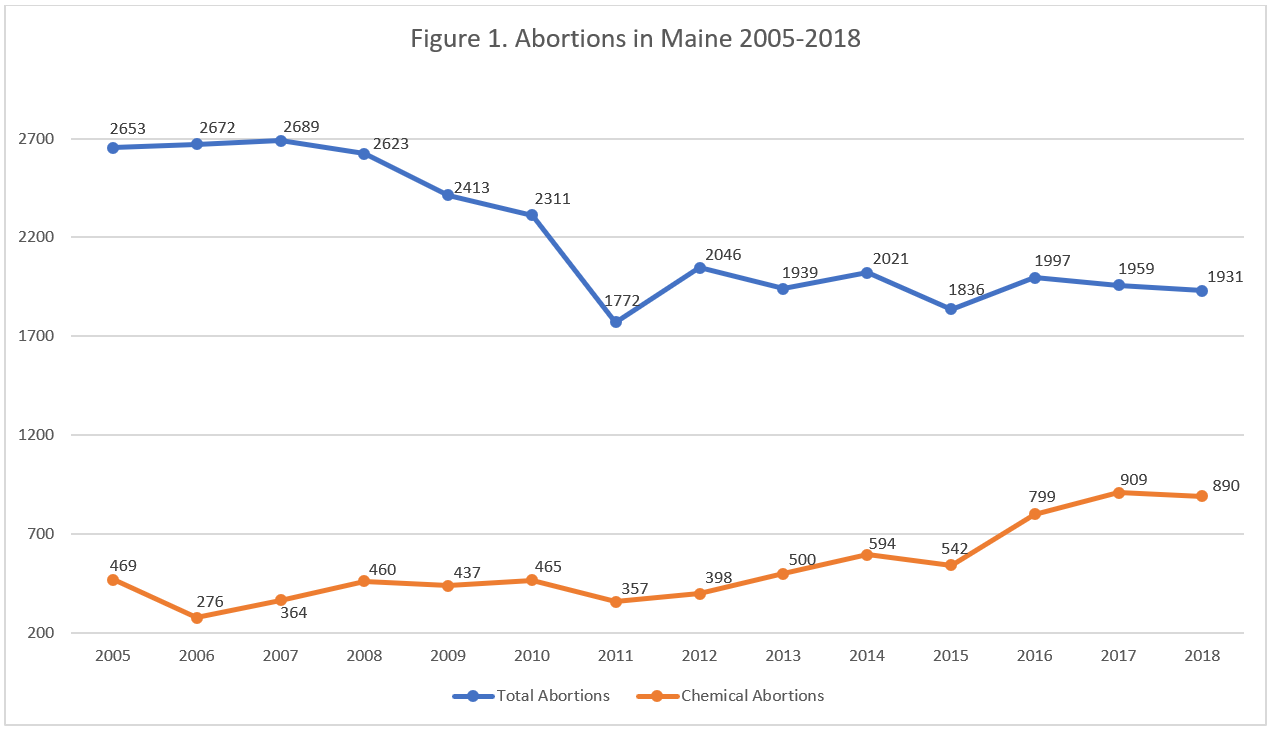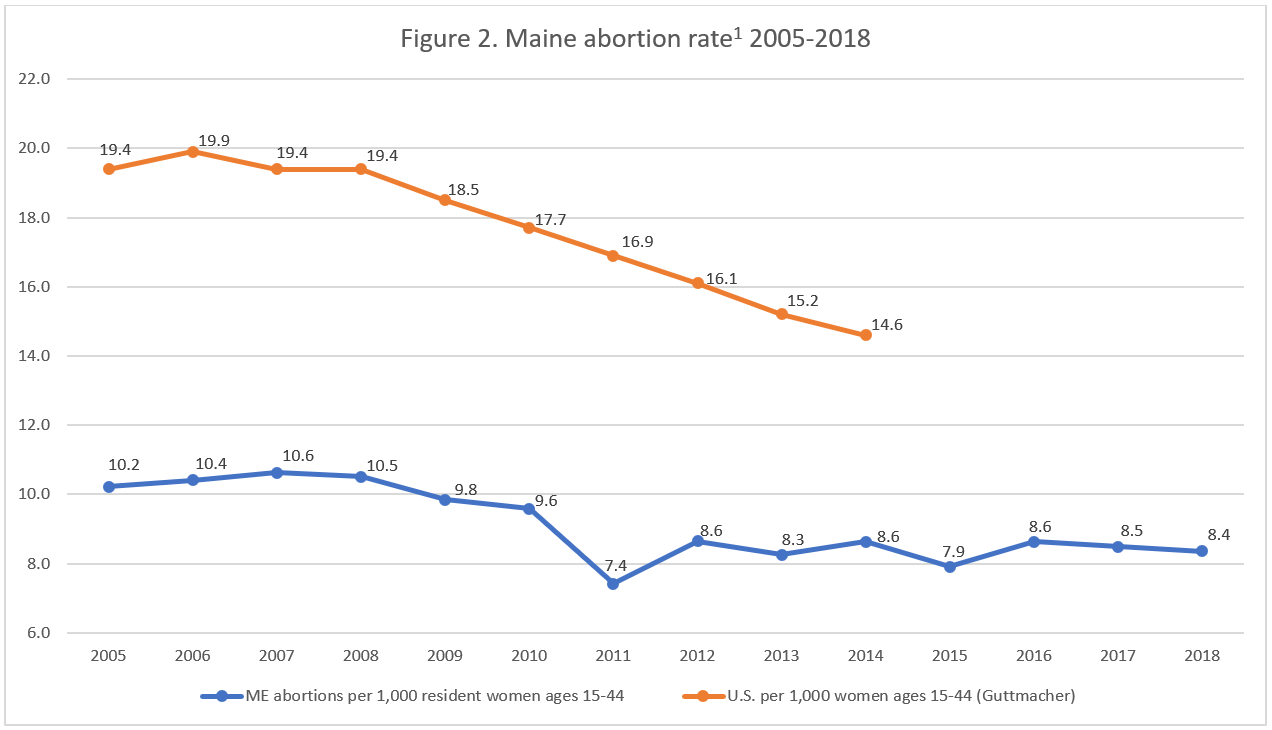Abortion Reporting: Maine (2018)
Maine’s abortion report for 2018, published on the website of the Maine Department of Health and Human Services in June 2019, shows that abortions in the state dropped slightly from the previous year.
Changes in Maine Abortions, 2017-2018

*Information on Planned Parenthood’s Maine market share is not publicly available.
Abortion Totals and Trends
In 2018, there were 1,931 abortions reported in Maine. Since 1999, Maine abortions have dropped by 20 percent, a difference of nearly 500 abortions. Abortions fell slightly by a little over one percent between 2017 and 2018 (Fig. 1). Chemical abortions dropped by two percent over the same period but have risen by more than 1,200 percent (over 800 abortions) from 2001, the first full year after the U.S. Food and Drug Administration approved the use of mifepristone to induce abortions. Chemical abortions made up 46 percent of the state total in 2018. The Charlotte Lozier Institute estimates that Maine’s abortion rate fell slightly from 2017 to 2018 (Fig. 2).
State Report Summary
Almost all the abortions reported in Maine, 95 percent, were performed on Maine residents. Four percent were performed on women from other states, including three percent on women from New Hampshire, and a little over half of one percent were performed on women of unknown residence. More than half (57 percent) were on women in their twenties. Ten percent were performed on women age 19 or younger, 29 percent on women in their thirties, and four percent on women age 40 or older. Eighty percent of the women were unmarried, while 16 percent were married, and four percent did not report their marital status.
White women made up a large majority of the women obtaining abortions in Maine. Eighty-five percent of Maine abortions were performed on white women, compared to five percent on black women, three percent on American Indian women, and six percent on women of other, unspecified races. Just one abortion was reported to have been performed on a woman of Asian heritage, while two percent were performed on women of unknown race. The black abortion rate was more than twice the white abortion rate in 2018: CLI estimates that there were 18.0 abortions per 1,000 black women of reproductive age, compared to 7.5 abortions per 1,000 white women of reproductive age.
Just over half of the women undergoing abortions had experienced a live birth. Twenty-two percent had one previous live birth, and 28 percent had more than one. In comparison, almost two-thirds (66 percent) had no previous abortions. Twenty-two percent had one prior abortion, and 12 percent had two or more. Eighty-two percent had no previous miscarriages.
Most of the abortions reported in Maine took place early in pregnancy. Seventy percent were performed earlier than nine weeks of gestation, and another 14 percent were performed between nine and 10 weeks. Seven percent occurred between 11 and 12 weeks, and six percent were performed between 13 and 15 weeks. Three percent of the abortions occurred between 16 and 19 weeks. No abortions were reported at or after 20 weeks, despite the fact that Maine allows abortions until the unborn baby is viable, and even after viability if the life or health of the mother is at risk. The state does not place any limits on the definition of “health.” Suction curettage was the most frequently used procedure, used to perform 48 percent of the abortions reported in Maine. Another 46 percent were chemical abortions. Five percent were dilation and evacuation procedures (dismemberment abortions), and three abortions (less than a fifth of a percent) were performed using sharp curettage. No abortions were reported to have been performed via intra-uterine instillation, hysterotomy, hysterectomy, or other procedures.
Abortion Providers in Maine
In June 2019, Maine amended its abortion law to allow non-physicians to perform abortions. Under the new legislation, there are no restrictions on the types of abortion procedures that physicians’ assistants and nurse practitioners are permitted to perform, even though the American Association of Pro-Life Obstetricians and Gynecologists cautions that permitting non-physicians to perform abortions can put women at risk. The new law may dramatically increase the number of abortion centers in Maine. Maine does not require health professionals to report complications caused by abortion, which means that any adverse effects of the new law will go largely undetected.
State Ranking
In the Charlotte Lozier Institute’s 2016 study of abortion reporting across the country, Maine’s reporting tied for 36th best. Maine law limits the state to collecting only the information on the U.S. Standard Report of Induced Termination of Pregnancy, underscoring the need for a better U.S. abortion reporting system. Even within the limitations imposed by state law, however, Maine could report all the data points it currently collects, including information on the facilities where abortions take place, the level of education of women who get abortions, and the county of residence and occurrence.


- Starting with the 2018 abortion reports, abortion rates are calculated by the Charlotte Lozier Institute to allow for easier state-to-state and year-to-year comparisons. Rates were calculated by CLI using population estimates from the United States Census Bureau. The rates were calculated using the following formula: (total number of abortions performed in Maine ÷ number of resident women ages 15-44) x 1,000. Rates may differ slightly from previous CLI articles due to revised population estimates.























